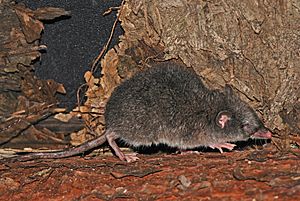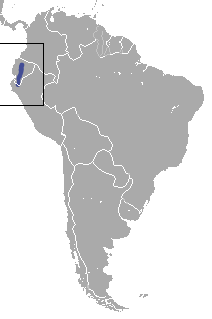Gray-bellied caenolestid facts for kids
Quick facts for kids Gray-bellied caenolestid |
|
|---|---|
 |
|
| Caenolestes caniventer in El Oro Province, Ecuador | |
| Conservation status | |
| Scientific classification | |
| Genus: |
Caenolestes
|
| Species: |
caniventer
|
 |
|
| Range of the gray-bellied caenolestid | |
The gray-bellied caenolestid (Caenolestes caniventer), also called the grey-bellied shrew opossum, is a small shrew opossum. It lives in wet, cool forests and damp grasslands. You can find it in western Ecuador and northwestern Peru.
An American scientist named Harold Elmer Anthony first described this animal in 1921. We don't know much about how it behaves. It seems to live on land (terrestrial) and is active around dawn or dusk (crepuscular) or at night (nocturnal). It eats insect larvae, small animals, and plants. The IUCN (a group that tracks animal populations) says the gray-bellied caenolestid is "near threatened." This means its numbers are getting low.
Contents
Discovering the Gray-Bellied Caenolestid
The gray-bellied caenolestid is one of five types of animals in the Caenolestes group. All these animals belong to the family Caenolestidae, which are known as shrew opossums.
Harold Elmer Anthony, an American zoologist, first officially described this animal in 1921. For many years, scientists thought Caenolestes was closely related to another group called Lestoros (which includes the Incan caenolestid). However, later studies showed that Lestoros looks quite different from Caenolestes.
In 2013, a study looked at how these animals are built (morphology) and their mitochondrial DNA. This study showed that the Incan caenolestid and the long-nosed caenolestid (Rhyncholestes raphanurus) are actually closer to each other. They form a "clade" (a group of animals that share a common ancestor) that is a "sister" group to Caenolestes.
The chart below shows how these animals are related:
|
|||||||||||||||||||||||||||||||||||||||||||||||||
Fossils of caenolestids show that they have been around for a very long time. They date back to the early Eocene period, which was almost 55 million years ago. The name Caenolestes comes from two Greek words: kainos, meaning "new," and lestes, meaning "robber" or "pirate."
How They Live: Behavior and Diet
Scientists still don't know much about the daily life of the gray-bellied caenolestid. It is a land-living creature. This means it spends its time on the ground, not in trees or water. It is also thought to be crepuscular or nocturnal. Crepuscular animals are active during twilight hours (dawn and dusk), while nocturnal animals are active at night.
The gray-bellied caenolestid seems to be an "opportunistic feeder." This means it eats whatever food it can find easily. When scientists studied the stomach contents of these animals from Peru, they found that most of their diet (up to 75%) was made up of invertebrate larvae. Invertebrates are animals without backbones, like arachnids (spiders, scorpions) and centipedes. They also eat small vertebrates (animals with backbones) and some plant material.
Reproduction
One interesting discovery was made in Ecuador. A female gray-bellied caenolestid was caught, and she was pregnant. She was found to have two babies developing inside her womb. This gives us a small clue about how they reproduce.
Where They Live and Their Status
The gray-bellied caenolestid prefers cool, damp places where it can find good hiding spots. It lives in wet, temperate forests high up in the mountains, sometimes as high as 2,900 metres (9,500 ft). It also lives in moist grasslands in warmer, subtropical areas. These animals often make small tunnels under tree roots near streams for shelter.
Their natural home stretches across western Ecuador and into northwestern Peru. The IUCN has listed the gray-bellied caenolestid as "near threatened." This means their population is decreasing. Since the 1990s, their numbers have dropped by almost 20%. The main reasons for this decline are deforestation (when forests are cut down) and agricultural expansion (when land is cleared for farming).
Luckily, the gray-bellied caenolestid can be found in some protected areas. These include Cajas National Park and the Mazán Ecological Reserve, which help keep their habitats safe.
See also
 In Spanish: Caenolestes caniventer para niños
In Spanish: Caenolestes caniventer para niños


